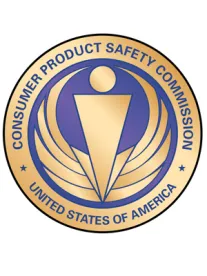Over the next several months, the U.S. Consumer Product Safety Commission (CPSC) will be reviewing the report and recommendations of an agency advisory panel regarding risks of phthalates in children’s products. If implemented by CPSC through rulemaking, the recommendations of the long-delayed report would restrict phthalates more stringently.
Background
On the basis of toxicity concerns primarily regarding potential endocrine disruption, section 108 of the Consumer Product Safety Improvement Act of 2008 (CPSIA)[1] requires the CPSC to convene a Chronic Hazard Advisory Panel (CHAP) to study the effects on children’s health of all phthalates and phthalate alternatives as used in children’s toys and child care articles.[2] A “children’s toy” is defined as a consumer product intended for children 12 years old or younger for use when playing; a “child care article” is a consumer product intended for children 3 years old or younger to facilitate sleeping or feeding, or to help a child who is sucking or teething.
Under section 108, three types of phthalates (DEHP, DBP, BBP) are banned permanently in any amount greater than 0.1% in children’s toys and certain child care articles. Three additional types of phthalates (DINP, DIDP, DNOP) were banned on an interim basis in any amount greater than 0.1% in children’s toys that can be placed in a child's mouth, and certain child care articles. The ban is implemented through third party testing and certification of plasticized components. The CHAP is required to make recommendations to CPSC regarding any phthalates (or combinations of phthalates) in addition to those identified in section 108 of the CPSIA or phthalate alternatives that the CHAP determines should be declared banned hazardous substances.
Findings and Recommendations
Under section 108, the CHAP report was due in February 2011, 30 months after enactment of CPSIA. The CHAP issued its report on July 18, 2014, more than three years later.[3] While it concluded that most phthalate exposures and risks come from food and personal care products—outside CPSC’s jurisdiction—it also determined that exposures from children’s toys and child care articles, “while relatively small, contribute to the overall risk.” Thus, the CHAP recommended adding a number of phthalates to either the interim or the permanent ban, although it also recommended removing two from the interim ban. Specifically, it recommended that CPSC:
-
permanently ban DIBP, DPENP, DHEXP, and DCHP, and impose an interim ban on DIOP, at levels above 0.1% in children’s toys and child care articles;
-
change the interim ban on DINP to permanent;
-
impose an interim ban on DIOP, at levels above 0.1% in children’s toys and child care articles; and
-
remove two phthalates, DNOP and DIDP, from the interim ban.
The report recommended no regulatory action on DMP, DEP, and DPHP. The report also recommended no regulatory action on phthalate alternatives, but it did encourage appropriate agencies to gather “necessary exposure and hazard data to estimate total exposure to the phthalate alternatives and assess the potential health risks.”
In light of the delay of the CHAP report, in March 2014, Sen. Kirsten Gillibrand (D-NY) introduced a bill, S. 2120, to essentially step in for the CHAP and the CPSC and legislatively expand the CPSIA’s existing interim ban on phthalates to more broadly cover all children’s products, including electronics not otherwise considered toys.[4] The CHAP report does not recommend such an expansion.
Reception and Next Steps
The CHAP report was criticized by the American Chemistry Council, which objected to its closed-door peer review and argued that CPSC did not follow several steps outlined in OMB guidelines for the integrity of the independent review process.[5] On the other hand, the CHAP report has been hailed by other groups such as Safer Chemicals, Healthy Families.[6]
The CHAP report has also received attention from legislators. On August 1, 2014, Rep. Henry A. Waxman (D-CA), Rep. Frank Pallone, Jr. (D-NY), and Rep. Jan Schakowsky (D-IL) sent a letter to newly sworn-in CPSC Chairman Elliot Kaye, calling the CHAP’s findings “alarming.” Their letter stated, “The hazards associated with phthalates and their ubiquity in everyday products underscore the needs for further regulatory action on and assessment of phthalates and phthalate substitutes. Although the statute requires CPSC to act within 180 days, we urge you to move forward on these actions without delay.”[7]
The CHAP’s findings are not determinative or binding on the CPSC, but the CPSC must, within 180 days after the CHAP report (i.e., by January 14, 2015), promulgate a final rule determining whether to continue section 108’s interim prohibitions, or to ban additional phthalates in any children’s product.
[1] Consumer Product Safety Improvement Act, P.L. 110-314 (Aug. 14, 2008), available athttp://www.cpsc.gov/PageFiles/129663/cpsia.pdf.
[2] See Beveridge & Diamond, P.C., “CPSC Requests Comments on Phthalates Ban,” Nov. 20, 2008, available at http://www.bdlaw.com/news-415.html.
[3] CPSC, Chronic Hazard Advisory Panel (CHAP) on Phthalates, http://www.cpsc.gov/en/Regulations-Laws--Standards/Statutes/The-Consumer-Product-Safety-Improvement-Act/Phthalates/Chronic-Hazard-Advisory-Panel-CHAP-on-Phthalates/
[4] S. 2120: A Bill To Expand The Prohibition On The Manufacture, Distribution, And Importation Of Children’s Products That Contain Phthalates, introduced Mar. 12, 2014, available at https://www.govtrack.us/congress/bills/113/s2120.
[5] American Chemistry Council, Press Release, “ACC Challenges the Conclusions of the CPSC CHAP Report on Phthalates Based on a Flawed CPSC Process,” July 18, 2014, available at http://www.americanchemistry.com/Media/PressReleasesTranscripts/ACC-news-releases/ACC-Challenges-the-Conclusions-of-the-CPSC-CHAP-Report-on-Phthalates-Based-on-a-Flawed-CPSC-Process.html.
[6] Safer Chemicals, Healthy Families, Press Release, “Strong Science Wins Despite Relentless Campaign from Big Chem,” Aug. 4, 2014, available at http://saferchemicals.org/2014/08/04/strong-science-wins-despite-relentless-campaign-from-big-chem/.
[7] House Energy and Commerce Committee Democrats, Press Release, “Reps. Waxman, Pallone, Schakowsky Urge FDA and CPSC to Take Swift Action on Phthalates,” Aug. 1, 2014, available at http://democrats.energycommerce.house.gov/index.php?q=news/reps-waxman-pallone-schakowsky-urge-fda-and-cpsc-to-take-swift-action-on-phthalates.





 />i
/>i